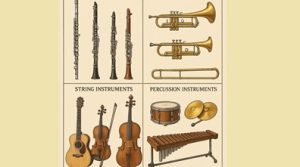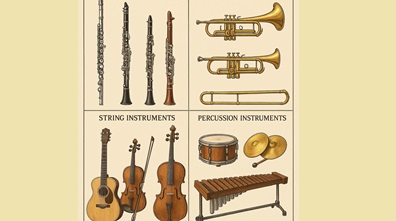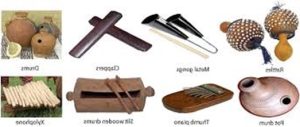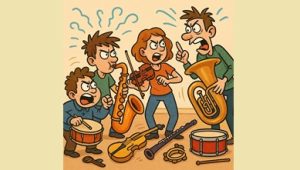The 4 Main Categories of Instruments Explained
The 4 Main Categories of Instruments Explained (With Hornbostel-Sachs Classification)
Music is universal, and instruments are the heart of it. Every sound you hear—whether from a guitar, drum, piano, trumpet, or flute—belongs to one of the main categories of instruments.
Learning these categories not only helps beginners pick the right instrument but also gives advanced musicians and students a deeper understanding of how music is created.

In this guide, we’ll break down:
- The 4 main categories of instruments in modern orchestras.
- The Hornbostel-Sachs classification system is used worldwide.
- Answers to common questions like: What is instrument classification? And is a cymbal a membranophone?
- The benefits of learning different instrument types.
Whether you’re just starting or you’re an aspiring professional musician, understanding the classification of instruments will give you a new appreciation for the sounds around you.
What Are the 4 Main Categories of Instruments?
Most musicians group instruments into four major categories based on how sound is produced. These are:
- Woodwind Instruments
- Brass Instruments
- String Instruments
- Percussion Instruments
Let’s explore each one.
1. Woodwind Instruments
Woodwind instruments produce sound when air is blown across a reed or into a mouthpiece. Despite the name, they aren’t always made of wood—flutes, for example, may be made from metal, silver, or even gold.
Examples: flute, clarinet, saxophone, bassoon, piccolo, recorder, harmonica.
Benefits of learning woodwind instruments:
- Improve lung capacity and breathing control.
- Strengthen posture and abdominal muscles.
- Build confidence when performing in orchestras or bands.
- Enhance hand-eye coordination.
2. Brass Instruments
Brass instruments are long, hollow tubes made of brass or metal. Players buzz their lips into a mouthpiece while pressing valves or slides to change pitch. These instruments are known for their powerful, bright sound and are often heard in orchestras, marching bands, and jazz ensembles.
Examples: trumpet, trombone, French horn, tuba, cornet.
Benefits of learning brass instruments:
- Develop strong breath control and endurance.
- Strengthen core muscles.
- Boost confidence and stage presence.
- Provide stress relief through expressive playing.
3. String Instruments
String instruments create sound when strings vibrate—either plucked, bowed, or struck. The pitch depends on string thickness, length, and tension. Strings are some of the oldest and most versatile instruments in the world.
Examples: guitar, violin, cello, double bass, harp, banjo, mandolin.
Benefits of learning string instruments:
- Improve focus, problem-solving, and math skills.
- Boost creativity and imagination.
- Release tension and improve mood.
- Provide multi-sensory learning experiences.
4. Percussion Instruments
Percussion instruments produce sound when they are struck, shaken, or scraped. They can be pitched (producing a specific note) or unpitched (producing rhythmic sounds without a clear pitch).
Examples: drums, cymbals, tambourine, triangle, maracas, xylophone.
Even the piano is considered a percussion instrument because pressing a key triggers hammers to strike strings inside.
Benefits of learning percussion instruments:
- Improve rhythm, coordination, and motor skills.
- Build endurance and physical strength.
- Provide a healthy outlet for energy and stress.
- Encourage teamwork and social interaction in bands and ensembles.
The Hornbostel-Sachs Classification System
Beyond the 4 common categories, musicologists often use the Hornbostel-Sachs classification system, created in 1914 by Erich Moritz von Hornbostel and Curt Sachs. It classifies instruments by how they produce sound, not just by appearance.
The main Hornbostel-Sachs categories include:
- Idiophones – Instruments that create sound from the material itself vibrating (e.g., xylophone, cymbals).
- Membranophones – Instruments with a stretched membrane that vibrates (e.g., drums, tambourines).
- Chordophones – Instruments with vibrating strings (e.g., guitar, violin).
- Aerophones – Instruments that produce sound by vibrating air (e.g., flute, trumpet).
- Electrophones – Instruments that use electricity to produce or amplify sound (e.g., synthesizers, electric guitar).
This system is widely common in ethnomusicology and organology because it applies across cultures, beyond Western orchestras.
FAQs About Instrument Classification
What is instrument classification?
Instrument classification is the system of grouping musical instruments based on how they produce sound. The most popular systems are the 4 main categories of instruments (woodwind, brass, string, percussion) and the more detailed Hornbostel-Sachs classification.
Is a cymbal a membranophone?
No, a cymbal is not a membranophone. A cymbal is an idiophone because the instrument itself vibrates to produce sound. Membranophones, like drums, require a stretched membrane (skin or synthetic head) to vibrate.
What is the Hornbostel-Sachs classification?
The Hornbostel-Sachs classification is a system for categorizing instruments into idiophones, membranophones, chordophones, aerophones, and electrophones. It’s one of the most detailed and widely used instrument classification methods worldwide.
How many categories of instruments are there?
Four main categories of instruments that are commonly: woodwind, brass, string, percussion. However, in academic studies, the Hornbostel-Sachs classification expands this to five main groups.

Wrapping Up
Learning the categories of instruments helps you understand music on a deeper level—whether you’re picking up your first instrument, joining an orchestra, or diving into music theory. From the sweet sounds of strings to the booming power of percussion, each category has unique benefits and challenges.
And remember—it’s never too late to learn a new instrument! Whether you want to play guitar, trumpet, piano, or drums, every instrument builds creativity, confidence, and joy.
When your music is ready, don’t stop at playing—promote it! Omari offers the best organic promotion services for Spotify, TikTok, Instagram, and YouTube. Get your sound to the audience it deserves.
Next Step: Choose an instrument from one of these categories, start practicing, and watch your musical journey grow!




